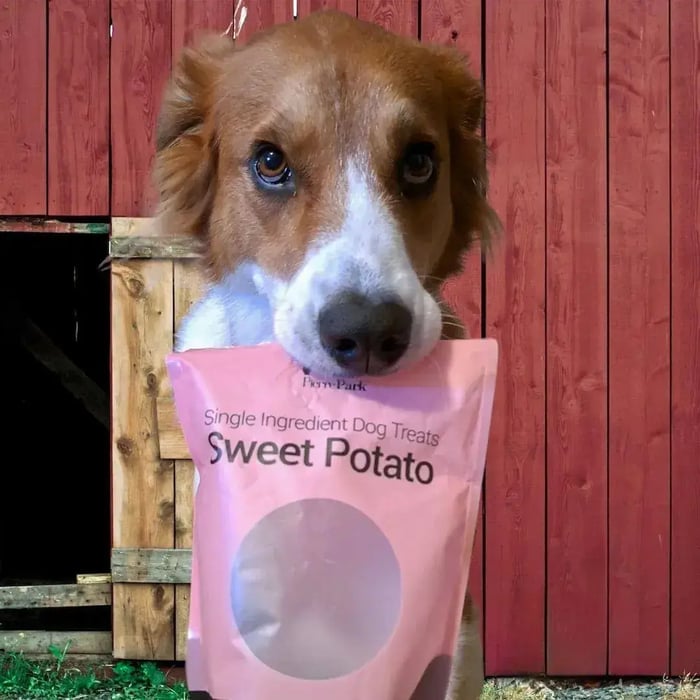Table of Contents
Vet-Approved

This article has been rigorously reviewed and validated by Dr. Annina Müller, med. vet., an accomplished veterinarian who earned her veterinary degree at the University of Bern, specializing in Small Animal Surgery. Her expertise ensures that the advice provided is both current and accurate in the field of veterinary medicine.
The practice of giving dogs treats before bedtime is common among pet owners. While it can be a beneficial routine when done responsibly, it's crucial to understand the proper approach to ensure your dog's health and well-being. This comprehensive guide explores the nuances of bedtime treat administration, potential benefits and risks, and best practices for optimal canine health.
Appropriate Treat Administration Before Bedtime
When administered correctly, giving treats before bed can be harmless and even beneficial:
1) Portion Control:
- Ensure the treat portion is small and within the dog's daily caloric allowance. The size and caloric content of treats can vary significantly, so it's essential to read labels carefully. As a general rule, treats should not exceed 10% of a dog's daily caloric intake.
- For example, if your dog requires 500 calories per day, all treats combined should not exceed 50 calories. This includes any treats given throughout the day, not just before bed.
2) Familiarity:
- Use treats the dog has consumed previously without adverse effects. Introducing new treats at bedtime can potentially lead to digestive upset or allergic reactions when you're less likely to notice symptoms.
- Keep a log of treats your dog tolerates well, and stick to these for bedtime routines. If you want to introduce a new treat, do so during the day when you can monitor your dog's reaction.
3) Positive Reinforcement:
- Treats can be effective for crate training or as a bonding opportunity before sleep. Using treats as part of a bedtime routine can help create positive associations with bedtime activities .
- For crate training, guide your dog into their crate with a treat, using a specific command like "bedtime" or "crate." Over time, this can help your dog associate their crate with positive experiences and make bedtime smoother.
Potential Concerns and Mitigation Strategies
While generally safe, certain scenarios may pose risks:
1) Excessive Treat Consumption:
Overfeeding treats can lead to:
- Unscheduled nighttime bathroom breaks: Dogs typically need to eliminate 6-8 hours after eating. Excessive treats before bed may disrupt their sleep and yours.
- Unwanted weight gain: Consistent overfeeding, even with small treats, can lead to obesity over time. Obesity in dogs can lead to numerous health issues, including joint problems, diabetes, and reduced lifespan.
Mitigation:
- Use a measuring cup or kitchen scale to portion treats accurately. If using treats for training or bonding, consider breaking them into smaller pieces to reduce overall calorie intake while still providing positive reinforcement.
2) Nutritional Imbalance:
- Treats should not exceed 10% of a dog's daily caloric intake. The majority (90%) should come from nutritionally complete dog food. Overreliance on treats can lead to nutritional deficiencies over time .
Mitigation:
- Ensure your dog's main diet consists of high-quality, nutritionally balanced dog food appropriate for their age, size, and activity level. Use treats as supplements, not meal replacements.
3) Gastrointestinal Distress:
- Introducing new treats at bedtime may cause digestive issues such as vomiting or diarrhea. These symptoms can be particularly problematic if they occur overnight .
Mitigation:
- Introduce new treats gradually during daytime hours. Start with a small piece and monitor your dog for any adverse reactions over 24-48 hours before incorporating the treat into their regular routine.
Optimal Treat Administration Practices
For maximum benefit and minimal risk:
1) Timing:
- The ideal time for treat administration is between meals during the day, particularly during training sessions. This allows for better monitoring of your dog's reaction and helps reinforce desired behaviors .
- If using treats before bed, try to maintain a consistent schedule. This can help regulate your dog's digestive system and prevent nighttime disturbances.
2) Quality:
- Opt for high-quality, single-ingredient treats, such as sweet potato treats, to minimize exposure to additives and preservatives. These treats are often easier to digest and less likely to cause allergic reactions .
- When selecting treats, look for those with recognizable ingredients and avoid artificial colors, flavors, or preservatives. Natural, single-ingredient treats can be particularly beneficial for dogs with sensitive stomachs or food allergies.
3) Human Food:
- Avoid using human food as treats due to potential toxicity risks for dogs . Many common human foods can be harmful or even toxic to dogs, including chocolate, grapes, onions, and foods containing xylitol.
- If you choose to give human food as an occasional treat, research thoroughly to ensure it's safe for dogs. Even safe human foods should be given in moderation and should not replace specially formulated dog treats.
Special Considerations
1) Bilious Vomiting Syndrome (BVS):
- For dogs with Bilious Vomiting Syndrome, a small bedtime snack or treat may help manage symptoms by preventing an empty stomach overnight . BVS is characterized by early morning vomiting of yellow bile, often due to an empty stomach.
- If your dog has been diagnosed with BVS, consult with your veterinarian about implementing a bedtime feeding routine. This might involve a small portion of their regular food or a specifically recommended treat. The goal is to keep some food in the stomach to prevent bile reflux.
2) Anxiety Management:
- While calming treats can be beneficial for occasional use, they should not be relied upon as a nightly sleep aid. Persistent sleep issues warrant veterinary consultation .
- Calming treats often contain ingredients like chamomile, L-theanine, or melatonin. These can be helpful for mild anxiety symptoms such as occasional pacing or lip licking. However, they are not a solution for chronic anxiety or sleep disorders.
- If your dog consistently has trouble settling down at night, it's important to address the underlying cause. This could be related to physical discomfort, anxiety, or other health issues that require professional veterinary attention.
Best Time to Feed Your Dog Treats
While bedtime treats can serve a purpose, the best time to feed your dog treats is generally between meals during the day, ideally during obedience training . This approach offers several benefits:
1) Training Reinforcement:
- Most dogs are highly food-motivated, making treats excellent rewards for positive reinforcement during training sessions.
2) Energy Utilization:
- Treats given during the day are more likely to be "burned off" through the dog's normal activities.
3) Monitoring:
- It's easier to observe any potential adverse reactions to treats when given during waking hours.
4) Avoiding Dependency:
- Feeding treats only in response to commands or desired behaviors helps prevent your dog from expecting treats without earning them.
FAQs
Are Certain Treats More Preferable to Others?
While the timing of treats is less critical than the quality and quantity, some treats are generally preferable. High-quality, single-ingredient treats like sweet potato dog treats are often recommended. These treats typically have fewer additives and are less processed, which can be beneficial for your dog's overall health .

What About Human Foods as Treats?
It's generally advisable to avoid feeding your dog human foods as treats, regardless of the time of day. Many human foods can be harmful or even toxic to dogs. For instance, foods containing garlic or onion are known to be toxic to dogs. Always research thoroughly before giving any human food to your dog, and consult with your veterinarian if you're unsure .
Can Calming Treats Be Beneficial Before Bed?
Calming treats can be effective, particularly for mild anxiety symptoms like occasional pacing or lip licking. However, they should not be relied upon as a nightly solution for sleep issues. If your dog consistently has trouble sleeping, it's important to address the underlying cause, which may require veterinary consultation .
How Can I Manage Bilious Vomiting Syndrome (BVS) with Bedtime Feeding?
For dogs diagnosed with Bilious Vomiting Syndrome, offering a small meal or treat before bedtime can be an effective management strategy. BVS is often characterized by early morning vomiting due to an empty stomach, which may be caused by the reflux of digestive fluids. Feeding a small portion before bed helps maintain stomach contents, reducing the likelihood of irritation and vomiting .
How Many Treats Can I Give My Dog Before Bed?
The number of treats should be based on your dog's size, weight, and overall daily caloric intake. As a general rule, treats should not exceed 10% of your dog's daily caloric intake. For bedtime treats specifically, a small portion that fits within this guideline is appropriate. Always consult with your veterinarian for personalized advice based on your dog's specific needs .
Conclusion
When administered responsibly, bedtime treats can be a positive part of a dog's routine. However, it's crucial to prioritize portion control, use familiar treats, and ensure they complement a balanced diet. The key points to remember are:
- Keep treat portions small and within the dog's daily caloric allowance.
- Use treats the dog has eaten before without issues.
- Be aware of potential problems like excessive treat consumption or nutritional imbalance.
- Consider the benefits of using treats for positive reinforcement, such as in crate training.
- Opt for healthy, single-ingredient treats when possible.
- Avoid human foods as treats due to potential toxicity risks.
- For dogs with specific conditions like Bilious Vomiting Syndrome, consult with a veterinarian about appropriate bedtime feeding strategies.
- While calming treats can be useful occasionally, they shouldn't be relied upon nightly for sleep issues.
Remember, every dog is unique, and what works for one may not work for another. Always observe your dog's reactions to any changes in their treat or feeding routine, and consult with a veterinarian if you have concerns about your dog's diet, health, or behavior.
By following these guidelines, you can ensure that bedtime treats remain a safe, enjoyable part of your dog's routine while maintaining their overall health and well-being.






